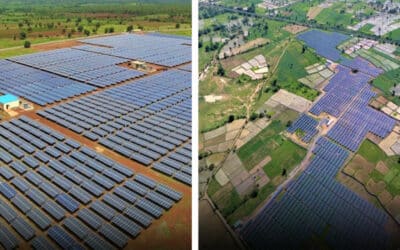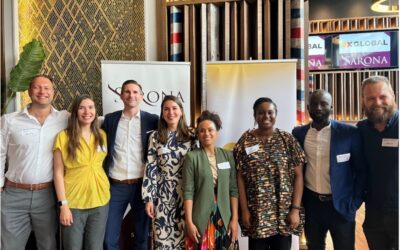
In a speech to a UN Heads of State reception at the 2016 High-Level Meeting on Ending AIDS Sarona founder and CEO Gerhard Pries declared that we won’t solve the SDGs without private-public partnerships. And Blended Finance is, without hesitation, the biggest bang for the buck. Guests at the reception included Mr. Secretary General, Ban Ki Moon and distinguished guests. The following is the text from the speech Pries delivered.
Download a PDF of the speech text.
UN High Level meeting on ending AIDS – Heads of State Reception – 07 June 2016
Thank you. It’s an honour to be with you this evening: Mr. Secretary General, Ban Ki Moon; Mr. President, Mogens Lykketoft; Your Excellencies and Ministers; Distinguished guests.
Google shocked the technology world a few months ago, when its Artificial Intelligence computer beat the world master in the game of Go. Google achieved that feat several years earlier than most IT gurus had anticipated.
Amazing. Stand still for just a minute, and the world has passed you by.
- What if one could connect AI computing to the visual imaging used in the quality control processes of auto manufacturing? Actually, that’s been done.
- What is one could nano-scale that visual imaging and apply it to micro-biology? Yup, that’s been done too.
- What if one could apply that nano-scale imaging, connected to AI computing, and apply it to Ebola diagnostics? And HIV diagnostics? And Zika virus diagnostics? And, and, and . . .? Well, that hasn’t been done, but it’s not far off.
Sightline Innovation Inc., a small Canadian company, is about to break open the world of bio-diagnostic testing. Using the same technology that it has installed in the automobile manufacturing sector, this small company, together with Canada’s National Micro-Biology Lab, is delivering a bio-diagnostic solution that is fast, accurate and low cost.
With every cheek-swabbed saliva image the company’s AI computer looks at, it learns to recognise more accurately what HIV looks like, and whether it is strain A, B or C. And, in the seconds it takes for the computer to make that diagnosis, it also checks for Ebola, Zika, influenza, and myriad other ills.
And with that, technology once again leap-frogs our built infrastructure to the benefit of humanity. These new technologies hold great hope for quick and inexpensive diagnostics across developing countries, but for one problem . . . who will pay for it? Sightline Innovation, that small Canadian company, is wholly funded by venture capital. Those investors may all have caring hearts, but are they prepared to develop technology with little prospect of revenue as it is rolled out across Africa?
Therein lies the crux of the problem that the Financing-for-Development conference in Addis Ababa was meant to address last July. New technologies and new health delivery models offer unprecedented opportunity for major strides in healthcare – they’re faster, they’re cheaper, they’re more accurate – yet the financing of those solutions remains unclear.
Who will pay?
Among the many things we learned from the 15-year MDGs, two stand out:
- economic growth fuelled by private investment were critical to the MDGs’ success, and
- neither the public sector, nor civil society nor the private sector stand a chance of creating a better world on their own.
Without partnerships, we have no hope of achieving the SDGs either. It is clear that the $40 trillion needed to achieve the SDGs will require the attention of the public, non-profit and private sectors.
Is it doable?
The Addis meetings last July were, for me, a watershed moment. Even a scant few years ago, we would not have heard, with any degree of clarity, the statements of acknowledgment and embrace that were mooted by disparate parties.
Public sector: “We now recognise that business is not the problem; business is an integral part of the solution.”
Across the street, at a hotel, under the auspices of the World Economic Forum:
Private sector: “We recognise and accept our responsibility not only to shareholders, but also to people, community and environment.”
Ladies and Gentlemen, therein lies the basis of partnership; therein lies our hope.
I don’t want be maudlin here, but when the left begins to move right, and the right begins to move left, we have the opportunity of true partnerships.
But can we muster the courage to forge new paths? Are we willing to take risks to pursue new models of development, new models of partnership?
Will the private sector be there?
I don’t represent the whole of the private sector, but increasingly, I can say that we care.
Our own firm – Sarona Asset Management – invests in private companies across Africa, Asia and Latin America. We target strong financial returns for our investors, and positive ethical, social and environmental outcomes wherever we invest.
Those two factors – finances and values – used to stand far apart. 20 years ago, our firm was a strangeling in the business community. Today, it is not only understood and accepted, but sought after.
In a recent study, PwC reports that SDG awareness in the business community is 92% compared to only 33% in the general population.
So yes, the private sector will be there. If we can partner with you, we will bring our technologies, our innovation, our capital, and our caring.
But will the public sector be there?
As public sector leaders, and guardians of society, you have the power to catalyse not billions, but trillions of dollars of private investment to make this world a better place. I recognise that the public sector works with scarce resources, and must therefore achieve the biggest bang for its buck. And to my mind, that is, without hesitation, Blended Finance.
Blended Finance is a public-private partnership, wherein the resources of the public sector catalyses the private sector to do that which it otherwise wouldn’t do. For example, three years ago, the Government of Canada provided a $15mm risk guarantee to our Sarona Frontier Markets Fund. In quick order, the fund ballooned to 10 times this value, driving private capital into mid-market companies in a careful dance of values and investment. The Canadian government will get its money back, and the private capital will continue to build up companies and communities in frontier and emerging markets.
If you acknowledge and support the private sector’s need for financial return, we will equally accept our responsibility to care. I invite you to hold our feet to the fire, to demand transparency and to target social and environmental goals. Ask us how we are contributing to the SDGs.
We know that healthy societies lead to healthier economies and, ultimately, to achievement of the SDGs. That requires the work of all economic actors – public and private. But unless we have the courage to reach across the divide that separates the public and private sectors, we will never achieve SDG #3. Yet by creating
incentives to meet each other’s goals, “Good Health” is in sight.
The world is changing quickly. And the handshake between the private and public sectors holds much promise for advancement in the human condition, and healthcare in particular. Let’s do it together.
Thank you


